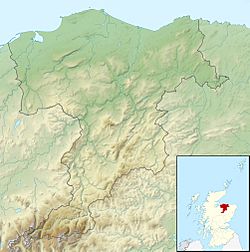Bellie facts for kids
Quick facts for kids Romancamp Gate |
|
|---|---|
| Alternative name(s) | Bellie |
| Type | Marching camp (possible) |
| Location | |
| Coordinates | 57°38′29″N 3°04′35″W / 57.6414°N 3.0763°W |
| Site notes | |
| Discovery year | 1799 |
| Bellie | |
|---|---|
| Alternative name(s) | Fochabers |
| Type | Marching camp (possible) |
| Location | |
| Coordinates | 57°38′06″N 3°04′58″W / 57.6349°N 3.0828°W |
| Site notes | |
| Discovery year | 1967 |
Bellie is a small area located in Moray, Scotland. It's known for its history and the exciting possibility of ancient Roman camps.
While not much remains of the old church at Bellie, its graveyard is still there. A newer church, called Bellie Kirk, was built in nearby Fochabers in 1798 to replace the old one.
What makes Bellie really interesting are the clues that suggest there might have been up to two Roman camps here. If these sites are confirmed as Roman, they would be the most northerly Roman camps ever found. They are about 10 miles (16 km) northwest of other known Roman camps at Auchinhove and Muiryfold.
Roman Camps: A Northern Mystery
Imagine Roman soldiers marching through Scotland! Bellie might have been a stop for them. Archaeologists have found evidence of two possible Roman camps in this area.
Romancamp Gate: The First Discovery
The first site is called Romancamp Gate. It's located very close to the old Bellie church, on a cliff overlooking the River Spey.
- First Clues: In 1799, a historian named George Chalmers wrote about "the remains of the Roman encampment." He described it as a rectangular shape, but much of it was already gone.
- Later Investigations: In the mid-1900s, another expert, O. G. S. Crawford, thought the site was too small for a Roman camp. He also noticed it didn't have clear gates, which Roman camps usually did.
- Air Photos and Damage: In 1943, special photos taken from the air showed lines in the ground, called cropmarks, which can reveal buried structures. However, during World War II, a military camp was built on the site, causing a lot of damage.
- Silver Finds: In 1964, two pieces of silver, dated to AD 51, were found nearby. This was an exciting clue!
- Digging for Answers: In 1971, archaeologists dug along one side of the site. They found a ditch, but they couldn't find enough evidence to prove it was definitely Roman.
The Second Site: More Clues
About 400 meters (1,300 feet) south of Romancamp Gate, another possible Roman site was explored.
- Kenneth St Joseph's Work: In 1967, archaeologist Kenneth St Joseph dug here. He found a V-shaped ditch, which is a common feature of Roman camps. It ran for a long distance and was quite deep in some places.
- Roman Style: St Joseph believed the ditch's shape and location strongly suggested it was Roman. He thought it might be part of a camp from the Flavian period (a time when Roman emperors like Vespasian, Titus, and Domitian ruled). This camp could have been quite large, covering about 30 acres (12 hectares).
- More Air Photos: In 1984, more aerial photos showed another line in the ground with a rounded corner, typical of Roman camps. When this was dug up in 1986, they found the shallow remains of another ditch.
- University Studies: Experts at the University of Cambridge have studied more aerial photos from the 1970s and 1980s. These photos seem to show more cropmarks that look like parts of a Roman camp, located east of the old Bellie church.
So, while not fully confirmed, the evidence at Bellie points to a fascinating Roman past, making it a very special place in Scottish history!


